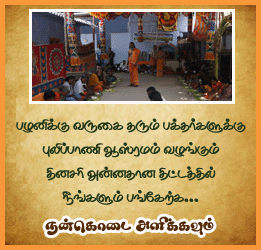
| FOLLOW US ON: | |||||||

HOME > Program/Classes > Yogasanam > Type of Yoga
The basis of ashtanga yoga is the Yoga sutras (Sanskrit Verses) of Patanjali. We will consider the different aspects of yoga while remaining under the guiding principles of Patanjali's Yoga (Ashtanga Yoga). The Asana, Pranayama, Dharana, Dhyan & Samadhi or the Yama and Niyama are systematically described by Patanjali in his Sanskrit Sutras (verses).
| 1. | Yama (Principles) |
| 2. | Niyama (Personal Disciplines) |
| 3. | Asana (Yoga Positions or Yogic Postures) |
| 4. | Pranayama (Yogic Breathing) |
| 5. | Pratyahara (Withdrawal of Senses) |
| 6. | Dharana (Concentration on Object) |
| 7. | Dhyan (Meditation) |
| 8. | Samadhi (Salvation) |
Bhakti Yoga: The Yoga of transcendent love, Divine Grace, and one pointed devotion to an ideal conception of divinity with the Hinduism devotee choosing to venerate deity as beloved, master, friend, parent/child. The Hindu Bhakti tradition disregarded caste systems and focused on genuine inner feelings and personal viewpoints to foster emotional well being, fulfillment, and the perceptual awareness of divinity pervading all aspects of Creation. Doing heartfelt service, Karma Yoga, was also integral to this path.
Hatha Yoga: The goal of the Hatha Yoga practitioner was health and vitality through rigorous training that involves many practices including breathing exercises (pranayama) and physical postures (asanas). When the postures and breathing exercises were mastered and the will trained to consciously control the vital energies of the physical and etheric bodies, the kundalini force was awakened at the base of the spine and used to open, purify, and vitalize the seven energy centers in the appropriate order.
Jnana Yoga: A difficult but profound path where the thinking philosopher sought union, peace, and liberation through information and discernment. Knowledge and wisdom were achieved by patiently releasing delusional thoughts and feelings until the meditator was attuned with the reality of Spirit. As the mind and heart blossomed with the illuminating realization that divinity was the inherent nature of the individual soul essence - first transformation and then eventual enlightenment occurred.
Karma Yoga: Linked to the fourth center, the Anahata or heart center, this yogic path centered on the universal karmic law of cause and effect. Transformation occurred when one learns to act out of love without attachment to immediately apparent results. By developing more responsible habits and attitudes, "new actions", the practitioner changed his feeling and thought patterns through right action and service resulting in "new reactions", realization and union with divinity.
Kriya Yoga: A yoga of transformation, Kriya combined the practices and disciplines of Bhakti, Jnana, and Raja Yoga. Over 5,000 years old, the technique was traditionally conveyed from the Guru directly to the spiritually mature initiate. The goal of the meditator was to achieve self realization by raising the serpent force of kundalini to the ninth center, the thousand petaled lotus, at the top of the head by following a daily program of devotion to divinity, introspection, and self-discipline.
Laya Yoga: The goal of the meditator was to transcend the lower levels of egoic, sensual, and material consciousness by awakening the seven energy centers (five were along the spine in the tailbone, in the sacrum, navel, heart, and throat areas; two were in the head in the third eye and crown areas). By concentrating on each of these energy centers in turn under the guidance of a qualified teacher, the meditator opened doorways to higher states of consciousness.
Mantra Yoga: Mantrams like AUM (spirit or word of God) were seed sounds that had been revealed to adepts which had the power to bring into being the actualities they represent. There were thousands of them in the Sanskrit language. As a meditator chanted these syllables, words, and phrases, mindfully, with increasing spiritual focus, the music, meaning, and cadence of the mantras repeatedly brought one to a transcendent state beyond intellect and emotions, resulting in a higher state of consciousness.
Raja Yoga: Yoga Sutras were used to move the kundalini lifeforce from the base of the spine to the throat center where the meditator transmuted the lesser passions into a desire to speak only of divinity and to seek serenity. By focusing attention on the objects of meditation, the practitioner then restored equilibrium to the mind and the emotions. Afterwards, the energy of this balanced awareness was usually directed to the third eye area called Ajna, in the middle of the lower forehead. This then resulted in the achievement of a state of sublime tranquility.
Tantra Yoga: The devotee strove to break through barriers of personal limitation and cross higher consciousness thresholds by using the fire of a masculine/feminine harmonized kundalini to transform negative habit patterns, obsessions, and subconscious blocks into the transmutative energy of the creative force as an universal expression of Spirit. When the spiritually awakened kundalini ascended and opened each energy center in turn, samadhi (direct experience of the Supreme Reality) was attained.
 |
 |
 |
 |
| SWAMY JEE INFO | SWAMY JEE PROGRAMS | KUNDALINI THEKSHA - SWAMY JEE | ASHRAM ADDRESS |
©
2012.Ssrimath Bhogar
|
||
| About Swamy Jee | Yoga Classes |  |
SRIMATH BHOGAR PALANI ATHEENAM, Pulippani Ashram, Adivaram. Palani - 624601. South India. Phone:+91 99942 16408, 78110 01166 E-mail: contact@siddharpulippanitradition.org |
|||
| Swamy Jee Books | Meditation Classes | |||||
| Swamy Jee TV interview | Spritual Camp | |||||
| Swamy Jee Video Gallery | Online Homam | |||||
| Swamy Jee Photo Gallery | Online Poojas | |||||


